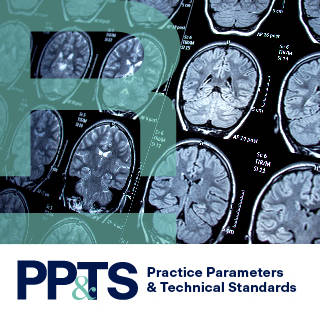Introduction
The practice parameters and technical standards are developed through consensus by experts from various practice settings and radiological subspecialties. These documents are not intended to establish, imply, or reflect “best practice” guidance, but are important to understanding the basic elements in providing quality radiological care.
The documents follow a well-organized development process which requires members’ and collaborating society representatives’ active participation at each stage of drafting, reviewing, and approving. For a more complete discussion of the program, please review the Practice Parameters and Technical Standards Development Handbook.
Document Drafting
A writing committee is constituted prior to drafting or revising documents for a given year. The documents go through an iterative review process until the committee reaches consensus. Literature searches are conducted to provide supporting evidence of recommendations of the documents. The documents that are collaborative with multiple medical specialty societies result in stronger recommendations that reduce potential bias and harmonize clinical recommendations.
Document Review
After completion of the initial draft or revision of a practice parameter or technical standard document, the document undergoes “field review ”; the process where the draft document is available for any ACR member and collaborating society to provide comments. All practice parameters and technical standards must complete field review before being considered for adoption by the ACR. This is the opportunity stakeholders external to the document drafting/revision process to comment. The comments are collated by staff, and then reviewed by the Chair of the Comment Reconciliation Committee, to determine which editorial comments can be accepted, or if substantive, should be considered by the Comment Reconciliation Committee for inclusion in the final draft to be presented for adoption. When a document completes the comment reconciliation process, it is considered final and ready for approval.
For more information on the comment reconciliation process, see “Review and Approval Process” section of the Practice Parameters and Technical Standards Development Handbook.
Document Approval
The final documents are sent to the relevant collaborating societies for acknowledgement if they are going through the Council approval process. The final version of the documents that Council has adopted or adopted as amended will be sent to the collaborating societies for each society’s final approval.
Documents that are not considered part of the Medical Physics approval process or the Radiation Oncology approval process are presented to the ACR Council for approval.
Council Approval Process
Each document that has completed field review will be presented to the ACR Council on a consent calendar as a resolution in accordance with the Standard Code of Parliamentary Procedure (formerly the Sturgis Standard Code of Parliamentary Procedure by Alice Sturgis). The practice parameters and technical standards will be adopted, adopted as amended, not adopted, or referred to the Board of Chancellors for action. There may be a specific BOC action with time restriction requested by the Council. For more details, see the section “Review and Approval Process” in the Practice Parameters and Technical Standards Development Handbook.
Medical Physics Approval Process
For Medical Physics documents that are collaborative with AAPM only, the final documents are reviewed and approved by AAPM, the Commission on Medical Physics, and the ACR Council Steering Committee and Board of Chancellors (Resolution 54 2015). For details see the section “Expedited Approval of ACR-AAPM Collaborative Medical Physics Practice Parameters and Technical Standards” in the Practice Parameters and Technical Standards Development Handbook.
Radiation Oncology Approval Process
For Radiation Oncology documents that are collaborative with radiation oncology societies only (eg, ASTRO, ABS, ARS, etc), the ACR Commission on Radiation Oncology and the ACR Commission on Medical Physics review and approve the final documents after the collaborating societies have reviewed and approved the document. Based on the recommendation of the ACR Commissions, the ACR Council Steering Committee, and the ACR Board of Chancellors reviews and approves the final document (Resolution 8 2010). For details, see the section “Process for Radiation Oncology Collaborative Practice Parameters and Technical Standards” in the Practice Parameters and Technical Standards Development Handbook.
Overall Process Timeline
The overall process to develop or revise a practice parameter or technical standard document is completed in 18 months. View timeline.
 ACR Practice Parameters and Technical Standards promote the safe and effective use of diagnostic and therapeutic radiology by describing specific training, skills and techniques. The goal is to narrow the variability among radiology practices and provide guidance to achieve quality in radiology.
ACR Practice Parameters and Technical Standards promote the safe and effective use of diagnostic and therapeutic radiology by describing specific training, skills and techniques. The goal is to narrow the variability among radiology practices and provide guidance to achieve quality in radiology.